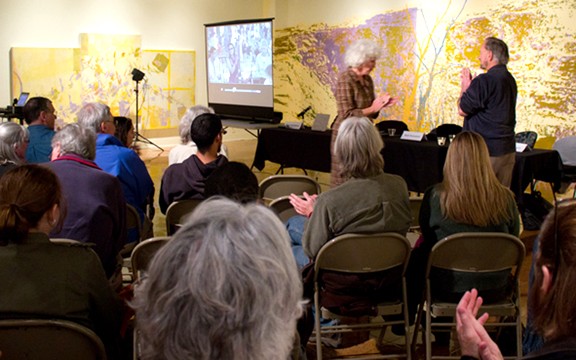A local non-profit was highlighted Thursday night at the UA Museum of Art as part of the museum’s “Broken Desert — Land and Sea” exhibition.
The exhibition will be on display until April and is a part of “Desert Initiative: Desert One,” a multi-state exploration of the issues and cultures of Southwestern deserts.
The Rillito River Project, founded in 2007, was the third group recognized in the exhibition and aims to raise awareness of global climate change through a series of art events.
“We had a group of artists come together for a week and we just decided to think, what could we do as artists to participate in the environmental conversation of what
is happening with climate change and make it understandable to the general public?” said Ellen Skotheim, creative director of the Rillito River Project.
These artists, architects, musicians, writers, builders and anthropologists create and plan artwork that is installed or performed in the riverbed of the dried up Rillito River.
Their goal is to call attention to the ecosystem that is no longer present due to the lack of water in the river. The group stages events using both art and science to advocate for social change and environmental awareness.
“The idea of the combination of science and environmental issues and art are appealing to me,” said Arlene Scadron, a retired Pima Community College professor who attended the lecture. “I think that’s really a brilliant idea to try to do that interdisciplinary effort to demonstrate and evoke in the public.”
Skotheim showcased the organization by bringing other members to speak about specific aspects of the project.
Skotheim highlighted many projects and events the group has created for the community, including the annual Bat Night, Art Lab, and their new book “Ground/Water: An Ode to a Dry River.”
Bat Night, an annual environmental performance art event held in the riverbed under the Campbell Avenue bridge, is named for the thousands of bats that live under the bridge and fly out every night.
The presenters also emphasized their current featured project, Art Lab, a collaborative exhibit that combines art and science to showcase a specific environmental topic. The Rillito River Project partnered with the UA Biosphere 2 this year to create “The Art of All Possibilities” exhibition located in Biosphere 2.
The Rillito River Project’s website describes the exhibit as a “conceptual and visual conversation with the scientific research, architecture and culture of Biosphere 2.” It explores the desert bioregion of Southern Arizona by combining scientific models and research with pieces of art inspired by the environment and climate change.
“The things that art can do better than science: expressing ways of knowing these issues in ways that are visual, visceral and viral,” said Gregg Garfin, deputy director for Science Translation and Outreach at the Institute of the Environment and a panel speaker at the event.
The exhibit will be at the Biosphere 2 through Feb. 28 and will then be transported to Uruguay as a part of an international environmental art and science campaign.
The project’s book, “Ground/Water: An Ode to a Dry River,” explores the history and science of the Rillito River. The book features art, writing and architecture examining the river and how it symbolizes global climate change. The book features artwork and research from UA professors and students.
“Scientist tend to speak to scientists, artists tend to speak to artists and nobody tends to speak to the public because they are just the public,” Skotheim said, “so our goal was to communicate and change people’s consciousness.”









